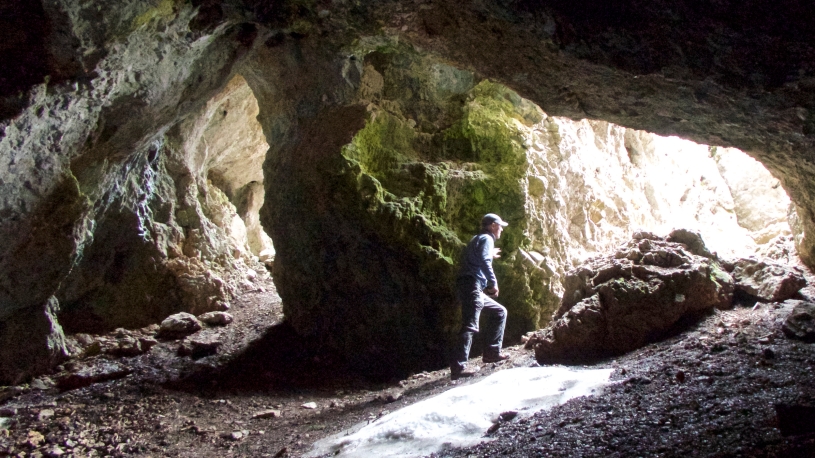Let me count the ways.
If there’s a better trail in central Montana than the 12-mile Ice Cave Loop south of Lewistown, somebody please tell me about it! I did the loop in 2009 and got to hike it again with my daughter (Amy) this past Saturday (8/24/19). The well-maintained trail climbs 2,200 feet from Crystal Lake to the crest of the Big Snowy Mountains. There is no bush-whacking, no scrambling up steep scree slopes, and nice long switch-backs make the slopes tolerable for experienced hikers. Once on the crest, you’re treated to one of the most expansive views in the state. Despite mostly cloudy skies, Amy and I enjoyed nice views of the Crazies, Highwoods, Little Belts, and Judith Mountains, and faint views of other more distant ranges. Vistas like this are usually enough to sell me, but the real draw for this hike is three unique features located along the trail – the Devil’s Chute (cave), Ice Cave, and Grandview Point.

Above: View of the Big Snowy Mountains from the highway south of Lewistown. It’s a 22-mile drive from the highway into the trailhead at Crystal Lake.
Somewhere in the middle of Montana.
Amy and I left Helena at 6 am, drove 210 miles to the trailhead at Crystal Lake, and started hiking at 10 am. We completed the hike in 5 hours and 45 minutes, averaging 2.7 mph when we were moving. Afterwards we drove into Lewistown to have a beer and dinner at the Big Spring Brewing before returning home (two thumbs up!). We arrived back in Helena at 9 pm. It’s always fun to spend the day with Amy and it was nice to see a part of the state that I don’t visit often enough. To learn more about the hike and see the sights (several photos taken in the ice cave), enjoy the photo tour – Be sure to read the captions. If you want to find out how it’s possible for ice to exist in a cave year-round, read on. (Photo Tour)
Ice in August?
The Devil’s Chute and Grandview Point are both interesting places, but Ice Cave is by far the main attraction. There probably are other ice caves scattered around the state, but this one and another in the Pryor Mountains southeast of Billing are the most popular. To earn designation as an “ice cave” a cave must remain cold enough to contain ice all year long. There are two key factors that may allow this to happen.
1. Colder air is heavier than warmer air.
Since molecules of cold air move slower than those of warmer air, colder air molecules tend to be closer together. This gives cold air a higher density (heavier for its volume) than warmer air. As a result, cold air that permeates the cave during winter tends to sink to the lowest location – in this case, the bottom of the cave. If the opening to the cave is in the right location, that winter-cooled air can sit there for a long time.
2. The opening must be above the cave.
When it comes to storing frozen foods, there are two basic types of freezer compartments. One kind is located along the bottom, top, or next to the refrigerator compartment. As you open the door, the cold air spills out onto the floor and is replaced with warmer air from the room. After you shut the door, electricity is used to re-cool the air so your ice cream doesn’t melt. These freezer compartments are like normal caves. A second type of freezer compartment opens from the top. This is more efficient because when opened from the top, the cold heavy air does spill out. Top-opening “chest freezers” are similar to ice caves. Ice caves are cold enough to sustain ice year-round because the entrance to the cave is located ABOVE the cave, therefore the cold air doesn’t spill out. Add enough water dripping into the cave from above, and you have yourself an ice cave!
Now you know. -Rod Benson
Below – An oldie, but a goodie: Watch this 5-minute video that I made after my trip to Ice Cave in 2009 – It was one of my students’ favorites.
- Photo Tour of our 12.3-mile hike.
Best viewed on a larger screen – Be sure to read the captions. - Map of the Ice Cave area 20 miles south of Lewistown.
Zoom in or out, scroll, drag, etc.
Below: This map marks hikes that have been featured on bigskywalker.com so far, including several in Glacier Park – Select full screen to expand, zoom in for more detail, or click on a marker for a link to the post.


Ha! I was looking for new place to go this coming holiday weekend and I remembered a coworker gushing about the Big Snowies. I thought, ‘Gee, I wonder if BigSkyWalker has done a hike there?’
Life is all about the timing!
LikeLiked by 1 person
Hi Rod:
Looks like you’re enjoying retirement with lots of hiking. Wonderful info on a unique place (ice cave). How difficult was the 6000 foot elevation climb? I wonder if there are places to camp along the trail?
On another note. Our son Dominick is visiting us on Sept 12,13. He really wants to climb the nose of the sleeping giant. Do you have any advice on how we could do that?
Ellen
LikeLike